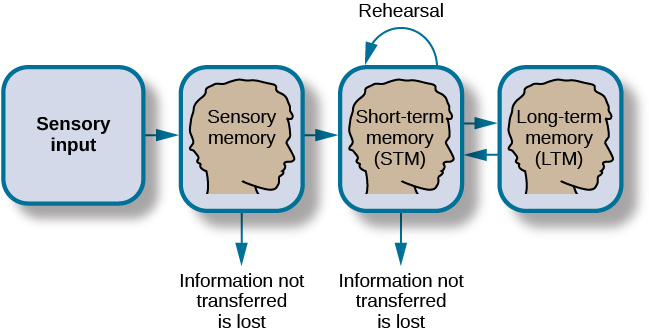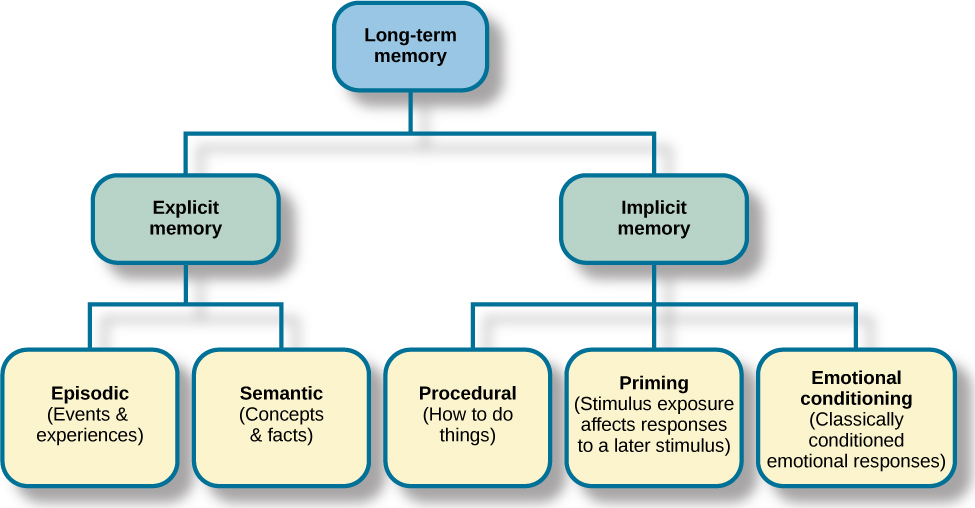50 How Memory Functions
Learning Objectives
By the end of this section, you will be able to:
- Discuss the three basic functions of memory
- Describe the three stages of memory storage
- Describe and distinguish between procedural and declarative memory and semantic and episodic memory
Memory is an information processing system; therefore, we often compare it to a computer. Memory is the set of processes used to encode, store, and retrieve information over different periods of time (Figure M.4).

Link to Learning
Watch this fun Crash Course video for a quick and engaging overview of How We Make Memories.
Encoding
We get information into our brains through a process called encoding, which is the input of information into the memory system. Once we receive sensory information from the environment, our brains label or code it. We organize the information with other similar information and connect new concepts to existing concepts. Encoding information occurs through automatic processing and effortful processing.
If someone asks you what you ate for lunch today, more than likely you could recall this information quite easily. This is known as automatic processing, or the encoding of details like time, space, frequency, and the meaning of words. Automatic processing is usually done without any conscious awareness. Recalling the last time you studied for a test is another example of automatic processing. But what about the actual test material you studied? It probably required a lot of work and attention on your part in order to encode that information. This is known as effortful processing (Figure M.5).

What are the most effective ways to ensure that important memories are well encoded? Even a simple sentence is easier to recall when it is meaningful (Anderson, 1984). Read the following sentences (Bransford & McCarrell, 1974), then look away and count backwards from 30 by threes to zero, and then try to write down the sentences (no peeking back at this page!).
- The notes were sour because the seams split.
- The voyage wasn’t delayed because the bottle shattered.
- The haystack was important because the cloth ripped.
How well did you do? By themselves, the statements that you wrote down were most likely confusing and difficult for you to recall. Now, try writing them again, using the following prompts: bagpipe, ship christening, and parachutist. Next count backwards from 40 by fours, then check yourself to see how well you recalled the sentences this time. You can see that the sentences are now much more memorable because each of the sentences was placed in context. Material is far better encoded when you make it meaningful.
There are three types of encoding. The encoding of words and their meaning is known as semantic encoding. It was first demonstrated by William Bousfield (1935) in an experiment in which he asked people to memorize words. The 60 words were actually divided into 4 categories of meaning, although the participants did not know this because the words were randomly presented. When they were asked to remember the words, they tended to recall them in categories, showing that they paid attention to the meanings of the words as they learned them.
Visual encoding is the encoding of images, and acoustic encoding is the encoding of sounds, words in particular. To see how visual encoding works, read over this list of words: car, level, dog, truth, book, value. If you were asked later to recall the words from this list, which ones do you think you’d most likely remember? You would probably have an easier time recalling the words car, dog, and book, and a more difficult time recalling the words level, truth, and value. Why is this? Because you can recall images (mental pictures) more easily than words alone. When you read the words car, dog, and book you created images of these things in your mind. These are concrete, high-imagery words. On the other hand, abstract words like level, truth, and value are low-imagery words. High-imagery words are encoded both visually and semantically (Paivio, 1986), thus building a stronger memory.
Now let’s turn our attention to acoustic encoding. You are driving in your car and a song comes on the radio that you haven’t heard in at least 10 years, but you sing along, recalling every word. In the Canada, children often learn the alphabet through song. This is easy to remember because of acoustic encoding. We encode the sounds the words make. This is one of the reasons why much of what we teach young children is done through song, rhyme, and rhythm.
Which of the three types of encoding do you think would give you the best memory of verbal information? Some years ago, psychologists Fergus Craik and Endel Tulving (1975) conducted a series of experiments to find out. Participants were given words along with questions about them. The questions required the participants to process the words at one of the three levels. The visual processing questions included such things as asking the participants about the font of the letters. The acoustic processing questions asked the participants about the sound or rhyming of the words, and the semantic processing questions asked the participants about the meaning of the words. After participants were presented with the words and questions, they were given an unexpected recall or recognition task.
Words that had been encoded semantically were better remembered than those encoded visually or acoustically. Semantic encoding involves a deeper level of processing than the shallower visual or acoustic encoding. Craik and Tulving concluded that we process verbal information best through semantic encoding, especially if we apply what is called the self-reference effect. The self-reference effect is the tendency for an individual to have better memory for information that relates to oneself in comparison to material that has less personal relevance (Rogers, Kuiper, & Kirker, 1977). Could semantic encoding be beneficial to you as you attempt to memorize the concepts in this chapter?
Storage
Once the information has been encoded, we have to somehow retain it. Our brains take the encoded information and place it in storage. Storage is the creation of a permanent record of information. In order for a memory to go into storage (i.e., long-term memory), it has to pass through three distinct stages: Sensory Memory, Short-Term Memory, and finally Long-Term Memory. These stages were first proposed by Richard Atkinson and Richard Shiffrin (1968). Their model of human memory (Figure M.6), called Atkinson and Shiffrin’s model, is based on the belief that we process memories in the same way that a computer processes information.

TRICKY TOPIC: ATKINSON-SHIFFRIN MODEL OF MEMORY
For a full transcript of this video, click here
TRICKY TOPIC: BADDELEY’S MODEL OF WORKING MEMORY
For a full transcript of this video, click here
Sensory Memory
In the Atkinson-Shiffrin model, stimuli from the environment are processed first in sensory memory: storage of brief sensory events, such as sights, sounds, and tastes. It is very brief storage—up to a couple of seconds. We are constantly bombarded with sensory information. We cannot absorb all of it, or even most of it. And most of it has no impact on our lives. For example, what was your professor wearing the last class period? Well as long as it wasn’t offensive to others, it does not really matter what they were wearing. Sensory information about sights, sounds, smells, and even textures, which we do not view as valuable information, we discard. If we view something as valuable, the information will move into our short-term memory system.
Short-Term Memory
Short-term memory (STM) is a temporary storage system that processes incoming sensory memory. The terms short-term and working memory are sometimes used interchangeably, but they are not exactly the same. Short-term memory is more accurately described as a component of working memory. Short-term memory takes information from sensory memory and sometimes connects that memory to something already in long-term memory. Short-term memory storage lasts 15 to 30 seconds. Think of it as the information you have displayed on your computer screen, such as a document, spreadsheet, or website. Then, information in STM goes to long-term memory (you save it to your hard drive), or it is discarded (you delete a document or close a web browser).
Rehearsal moves information from short-term memory to long-term memory. Active rehearsal is a way of attending to information to move it from short-term to long-term memory. During active rehearsal, you repeat (practice) the information to be remembered. If you repeat it enough, it may be moved into long-term memory. For example, this type of active rehearsal is the way many children learn their ABCs by singing the alphabet song. Alternatively, elaborative rehearsal is the act of linking new information you are trying to learn to existing information that you already know. For example, if you meet someone at a party and your phone is dead but you want to remember his phone number, which starts with area code 203, you might remember that your uncle Abdul lives in Connecticut and has a 203 area code. This way, when you try to remember the phone number of your new prospective friend, you will easily remember the area code. Craik and Lockhart (1972) proposed the levels of processing hypothesis that states the deeper you think about something, the better you remember it.
You may find yourself asking, “How much information can our memory handle at once?” To explore the capacity and duration of your short-term memory, have a partner read the strings of random numbers (Figure M.7) out loud to you, beginning each string by saying, “Ready?” and ending each by saying, “Recall,” at which point you should try to write down the string of numbers from memory.

Note the longest string at which you got the series correct. For most people, the capacity will probably be close to 7 plus or minus 2. In 1956, George Miller reviewed most of the research on the capacity of short-term memory and found that people can retain between 5 and 9 items, so he reported the capacity of short-term memory was the “magic number” 7 plus or minus 2. Generally, recall is somewhat better for random numbers than for random letters (Jacobs, 1887) and also often slightly better for information we hear (acoustic encoding) rather than information we see (visual encoding) (Anderson, 1969).
Memory trace decay and interference are two factors that affect short-term memory retention. Peterson and Peterson (1959) investigated short-term memory using the three letter sequences called trigrams (e.g., CLS) that had to be recalled after various time intervals between 3 and 18 seconds. Participants remembered about 80% of the trigrams after a 3-second delay, but only 10% after a delay of 18 seconds, which caused them to conclude that short-term memory decayed in 18 seconds. During decay, the memory trace becomes less activated over time, and the information is forgotten. So, we can say that without rehearsal, information is lost from working memory after 18 seconds. However, Keppel and Underwood (1962) examined only the first trials of the trigram task and found that proactive interference also affected short-term memory retention. During proactive interference, previously learned information interferes with the ability to learn new information. Both memory trace decay and proactive interference affect short-term memory. Once the information reaches long-term memory, it has to be consolidated at both the synaptic level, which takes a few hours, and into the memory system, which can take weeks or longer.
Long-term Memory
Long-term memory (LTM) is the continuous storage of information. Unlike short-term memory, long-term memory storage capacity is believed to be unlimited. It encompasses all the things you can remember that happened more than just a few minutes ago. One cannot really consider long-term memory without thinking about the way it is organized. Really quickly, what is the first word that comes to mind when you hear “peanut butter”? Did you think of jelly? If you did, you probably have associated peanut butter and jelly in your mind. It is generally accepted that memories are organized in semantic (or associative) networks (Collins & Loftus, 1975). A semantic network consists of concepts, and as you may recall from what you’ve learned about memory, concepts are categories or groupings of linguistic information, images, ideas, or memories, such as life experiences. Although individual experiences and expertise can affect concept arrangement, concepts are believed to be arranged hierarchically in the mind (Anderson & Reder, 1999; Johnson & Mervis, 1997, 1998; Palmer, Jones, Hennessy, Unze, & Pick, 1989; Rosch, Mervis, Gray, Johnson, & Boyes-Braem, 1976; Tanaka & Taylor, 1991). Related concepts are linked, and the strength of the link depends on how often two concepts have been associated.
Semantic networks differ depending on personal experiences. Importantly for memory, activating any part of a semantic network also activates the concepts linked to that part to a lesser degree. The process is known as spreading activation (Collins & Loftus, 1975). If one part of a network is activated, it is easier to access the associated concepts because they are already partially activated. When you remember or recall something, you activate a concept, and the related concepts are more easily remembered because they are partially activated. However, the activations do not spread in just one direction. When you remember something, you usually have several routes to get the information you are trying to access, and the more links you have to a concept, the better your chances of remembering.
There are two types of long-term memory: explicit and implicit (Figure M.8). Understanding the difference between explicit memory and implicit memory is important because aging, particular types of brain trauma, and certain disorders can impact explicit and implicit memory in different ways. Explicit memories are those we consciously try to remember, recall, and report. For example, if you are studying for your chemistry exam, the material you are learning will be part of your explicit memory. In keeping with the computer analogy, some information in your long-term memory would be like the information you have saved on the hard drive. It is not there on your desktop (your short-term memory), but most of the time you can pull up this information when you want it. Not all long-term memories are strong memories, and some memories can only be recalled using prompts. For example, you might easily recall a fact, such as the capital of the United States, but you might struggle to recall the name of the restaurant at which you had dinner when you visited a nearby city last summer. A prompt, such as that the restaurant was named after its owner, might help you recall the name of the restaurant. Explicit memory is sometimes referred to as declarative memory, because it can be put into words. Explicit memory is divided into episodic memory and semantic memory.
Episodic memory is information about events we have personally experienced (i.e., an episode). For instance, the memory of your last birthday is an episodic memory. Usually, episodic memory is reported as a story. The concept of episodic memory was first proposed about in the 1970s (Tulving, 1972). Since then, Tulving and others have reformulated the theory, and currently scientists believe that episodic memory is memory about happenings in particular places at particular times—the what, where, and when of an event (Tulving, 2002). It involves recollection of visual imagery as well as the feeling of familiarity (Hassabis & Maguire, 2007). Semantic memory is knowledge about words, concepts, and language-based knowledge and facts. Semantic memory is typically reported as facts. Semantic means having to do with language and knowledge about language. For example, answers to the following questions like “what is the definition of psychology” and “who was the first Prime Minister of Canada” are stored in your semantic memory.
Implicit memories are long-term memories that are not part of our consciousness. Although implicit memories are learned outside of our awareness and cannot be consciously recalled, implicit memory is demonstrated in the performance of some task (Roediger, 1990; Schacter, 1987). Implicit memory has been studied with cognitive demand tasks, such as performance on artificial grammars (Reber, 1976), word memory (Jacoby, 1983; Jacoby & Witherspoon, 1982), and learning unspoken and unwritten contingencies and rules (Greenspoon, 1955; Giddan & Eriksen, 1959; Krieckhaus & Eriksen, 1960). Returning to the computer metaphor, implicit memories are like a program running in the background, and you are not aware of their influence. Implicit memories can influence observable behaviours as well as cognitive tasks. In either case, you usually cannot put the memory into words that adequately describe the task. There are several types of implicit memories, including procedural, priming, and emotional conditioning.

Link to Learning
Watch this video that explores the difference between short- and long-term memory and how they’re stored.
Implicit procedural memory is often studied using observable behaviours (Adams, 1957; Lacey & Smith, 1954; Lazarus & McCleary, 1951). Implicit procedural memory stores information about the way to do something, and it is the memory for skilled actions, such as brushing your teeth, riding a bicycle, or driving a car. You were probably not that good at riding a bicycle or driving a car the first time you tried, but you were much better after doing those things for a year. Your improved bicycle riding was due to learning balancing abilities. You likely thought about staying upright in the beginning, but now you just do it. Moreover, you probably are good at staying balanced, but cannot tell someone the exact way you do it. Similarly, when you first learned to drive, you probably thought about a lot of things that you just do now without much thought. When you first learned to do these tasks, someone may have told you how to do them, but everything you learned since those instructions that you cannot readily explain to someone else as the way to do it is implicit memory.
Implicit priming is another type of implicit memory (Schacter, 1992). During priming exposure to a stimulus affects the response to a later stimulus. Stimuli can vary and may include words, pictures, and other stimuli to elicit a response or increase recognition. For instance, some people really enjoy picnics. They love going into nature, spreading a blanket on the ground, and eating a delicious meal. Now, unscramble the following letters to make a word.
AETPL
What word did you come up with? Chances are good that it was “plate.”
Had you read, “Some people really enjoy growing flowers. They love going outside to their garden, fertilizing their plants, and watering their flowers,” you probably would have come up with the word “petal” instead of plate.
Do you recall the earlier discussion of semantic networks? The reason people are more likely to come up with “plate” after reading about a picnic is that plate is associated (linked) with picnic. Plate was primed by activating the semantic network. Similarly, “petal” is linked to flower and is primed by flower. Priming is also the reason you probably said jelly in response to peanut butter.
Implicit emotional conditioning is the type of memory involved in classically conditioned emotion responses (Olson & Fazio, 2001). These emotional relationships cannot be reported or recalled but can be associated with different stimuli. For example, specific smells can cause specific emotional responses for some people. If there is a smell that makes you feel positive and nostalgic, and you don’t know where that response comes from, it is an implicit emotional response. Similarly, most people have a song that causes a specific emotional response. That song’s effect could be an implicit emotional memory (Yang, Xu, Du, Shi, & Fang, 2011).
Everyday Connection
Can You Remember Everything You Ever Did or Said?
Episodic memories are also called autobiographical memories. Let’s quickly test your autobiographical memory. What were you wearing exactly five years ago today? What did you eat for lunch on April 10, 2009? You probably find it difficult, if not impossible, to answer these questions. Can you remember every event you have experienced over the course of your life—meals, conversations, clothing choices, weather conditions, and so on? Most likely none of us could even come close to answering these questions; however, American actress Marilu Henner, best known for the television show Taxi, can remember. She has an amazing and highly superior autobiographical memory (Figure M.9).

Link to Learning
Watch this video about superior autobiographical memory from the show 60 Minutes, to learn more.
Retrieval
So you have worked hard to encode (via effortful processing) and store some important information for your upcoming final exam. How do you get that information back out of storage when you need it? The act of getting information out of memory storage and back into conscious awareness is known as retrieval. This would be similar to finding and opening a paper you had previously saved on your computer’s hard drive. Now it’s back on your desktop, and you can work with it again. Our ability to retrieve information from long-term memory is vital to our everyday functioning. You must be able to retrieve information from memory in order to do everything from knowing how to brush your hair and teeth, to driving to work, to knowing how to perform your job once you get there.
There are three ways you can retrieve information out of your long-term memory storage system: recall, recognition, and relearning. Recall is what we most often think about when we talk about memory retrieval: it means you can access information without cues. For example, you would use recall for an essay test. Recognition happens when you identify information that you have previously learned after encountering it again. It involves a process of comparison. When you take a multiple-choice test, you are relying on recognition to help you choose the correct answer. Here is another example. Let’s say you graduated from high school 10 years ago, and you have returned to your hometown for your 10-year reunion. You may not be able to recall all of your classmates, but you recognize many of them based on their yearbook photos.
The third form of retrieval is relearning, and it’s just what it sounds like. It involves learning information that you previously learned. Jaylin took French in high school, but after high school they did not have the opportunity to speak French. Jaylin is now 31, and the company they work for has offered Jaylin an opportunity to work in their Montreal office. In order to prepare, Jaylin enrolls in a French course at the local community centre. Jaylin is surprised at how quickly they’re able to pick up the language after not speaking it for 13 years; this is an example of relearning.

